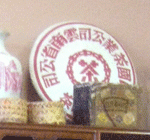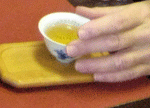There Must Be More to Life
 “There must be more to life than having everything,” says Jennie, a discontented Sealyham terrier. So, she leaves home carrying her black leather bag with the gold buckles. She discovers that even though she has everything, she’s missing Experience. Unfortunately, she needs Experience in order to fulfill her aspiration of being the leading lady in the World’s Mother Goose Theater. And so begins her trek to find Experience, a word she doesn’t even comprehend, “Never heard of it.”
“There must be more to life than having everything,” says Jennie, a discontented Sealyham terrier. So, she leaves home carrying her black leather bag with the gold buckles. She discovers that even though she has everything, she’s missing Experience. Unfortunately, she needs Experience in order to fulfill her aspiration of being the leading lady in the World’s Mother Goose Theater. And so begins her trek to find Experience, a word she doesn’t even comprehend, “Never heard of it.”
To be Thankful for so many things in our lives
There’s so much to be thankful for. I like this video, because it reminds me of those many things there are to be thankful for.
I find that on those days when things don’t work out, or I’m not feeling well, or I’m surrounded by grumpy, pushy people, it really helps to think about those things in my life to be thankful for.
Continue reading
Health tip: Drink pu-erh Chinese tea to lower cholesterol and triglycerides
Another thing I’ve learned from visiting Chinese tea houses is that pu-erh tea, which sounds a lot like “poor” but is pronounced more like poo-er with the accent on the first syllable, is supposed to be a very healthy drink. When I visited The Best Tea House in Richmond, British Columbia, the proprietor Michael Fung’s assistant tried to get me to pronounce it correctly in Chinese, but I finally gave up after exhausting my tongue.
The Best Tea House specializes in pu-erh tea. This is a tea that is considered medicinal in China, although it is made from the leaves of the same tea plant (Camellia sinensis) that produces green (unfermented), oolong (partially fermented), and black (fully fermented) teas. Pu-erh is not only fermented but also aged for a long time, usually years.

Michael Fung’s The Best Tea House in Richmond, BC. Note the wrapped Pu-erh tea cakes on the upper right and left shelves.
To my senses, pu-erh tea cake or brick, before it’s steeped, smells like hay in a stable – a pleasant earthy aroma – but just a bit strange when you consider that you’re going to break a piece off, infuse it with hot water, steep it, and then drink the resulting tea. However, after it’s steeped – and the Gong Fu style of tea drinking is often used for savoring pu-erh – it smells, to me, more like black tea. I like that it has less caffeine that green, oolong or black tea.
According to an article on “Pu-erh” in WebMD, not only does pu-erh contain less caffeine, which stimulates the central nervous system, heart, and muscles (Eek, maybe I should lighten up on the green tea), but also pu-erh contains antioxidants and “other substances that might protect the heart and blood vessels.”
Michael Fung suggested puerh tea for me, because it is “warm” rather than “cold” like green tea, and will therefore be less likely to create agitation in the body, as I understood him. I assume the “warm” and “cold” refer to properties in Chinese medicine.
OK, so here’s the really exciting part: I was surprised to read in the WebMD article that studies have shown that drinking pu-erh tea can reduce cholesterol. The article surmises that this can be due to pu-erh containing small amounts of a chemical called lovastatin, which is prescribed to lower cholesterol. Other research indicates that drinking pu-erh tea may lower triglycerides as well as low-density lipoprotein LDL (“bad” cholesterol) and raise high-density lipoprotein HDL (“good” cholesterol).
Interestingly, a Financial Times article about California cooking expert Alice Waters says that Alice has attributed a personal cholesterol drop of 100 points to puerh tea!
Wow! I’m getting encouraged to get over my issues with pu-erh’s hay/stable aroma.
According to the WebMD article on puerh tea, it is produced mainly in the southwestern part of China in the Yunnan district. Michael Fung told me that this area also has many tall old tea trees – ancient tea trees, some of them hundreds or even thousands of years old.
Tea trees? I thought tea leaves grew on bushes. Well, it turns out that the tea plant will become a tree and that there are wild old tea trees in Yunnan, China. For a photo of an old tea tree, take a look at Andrew Stein’s Wild China blog post, The Ancient Tea Trees of Southern Yunnan.
Photographs by John J. Chapman, used with permission.
Continue reading
